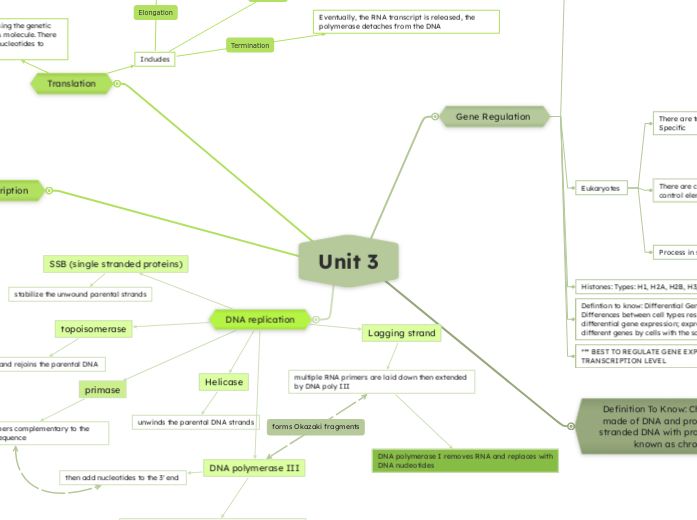Unit 3
Gene Regulation
Prokayotes
DEFINITION TO KNOW: Operons: A cluster of functionally related genes can be under coordinated control of a single on-off "switch"
Positive and Negative Controls Exist
Positive Regulation: When activator is bound to the operator, transcription occurs; when no activator is present, no transcription will occur
Negative Regulation: When repressor is bound to the operator, no transcription occurs; when no repressor is bound, transcription occurs
Example of regulation: Lac Operon
Structural genes for Lac Operon: LacZ, LacY, LacA
LacZ: B-galactosidase
LacY: Permease
LacA: Trans-acetylase
Organization of lac operon: DNA, promoter, regulatory gene, promoter for structural genes, operator, Z,Y,A genes
When lactose is present, the gene expression will be turned on because Lac repressor protein binds to lactose; as a result, RNAp can bind to promoter
When no lactose is present, Lac I makes a Lac repressor proteins that binds to the operator sequence and prevents expression of the lac operon structural genes
If there is also no glucose and no lactose present, the operon is ON!
CAP is activated by cAMP; cAMP binds to CAP and helps RNAP bind to promoter to facilitate transcription = operon is on!
**If there is no cAMP because of the presence of glucose that blocks Adenylyl Cyclase, CAP cannot be activated and if CAP is not active, it cannot help RNAP bind to the promoter = operon is OFF!
Eukaryotes
There are transcription factors: General and Specific
General: background/basal level of transcription
Specific: Activators and repressors involved to either increase levels of transcription or decrease
There are control elements in DNA: Proximal control elements and distal control elements
Proximal control elements: sequences in DNA close to promoter as well as bind general transcription factors
Distal control elements: There are enhancers and bind to specific transcription factors (activators and repressors)
Location: Sequences in DNA upstream or downstream of gene; possibly close or far away from gene
Process in steps:
Step 1: Activator proteins bind to distal control elements
Step 2: A DNA-bending protein brings activators closer to promoter, there are general transcription factors, mediator proteins, and RNA polymerase II
Step 3: Activators bind to certain mediator proteins and general transcription factors
Histones: Types: H1, H2A, H2B, H3, H4
Histone core: H2A, H2B, H3, H4
Defintion to know: Differential Gene Expression: Differences between cell types result from differential gene expression; expression of different genes by cells with the same genome
*** BEST TO REGULATE GENE EXPRESSION AT TRANSCRIPTION LEVEL
Definition To Know: Chromosomes: made of DNA and proteins; double stranded DNA with protein attached known as chromatin
When compacted, it's called a chromosome
Translation
The synthesis of a polypeptide using the genetic information encoded in an mRNA molecule. There is a change of “language” from nucleotides to amino acids.
A complex of rRNA and protein molecules that functions as a site of protein synthesis in the cytoplasm; consists of a large subunit and a small subunit.
3 Active Sites
A complex of rRNA and protein molecules that functions as a site of protein synthesis in the cytoplasm; consists of a large subunit and a small subunit.
One of a ribosome’s three binding sites for tRNA during translation. The P site holds the tRNA carrying the growing polypeptide chain. (P stands for peptidyl tRNA.)
One of a ribosome’s three binding sites for tRNA during translation. The E site is the place where discharged tRNAs leave the ribosome. (E stands for exit.)
An RNA molecule that functions as a translator between nucleic acid and protein languages by picking up a specific amino acid and carrying it to the ribosome, where the tRNA recognizes the appropriate codon in the mRNA.
Includes
After RNA polymerase binds to the promoter,
the polymerase unwinds the DNA strands and initiates RNA synthesis at the start point on the template strands
The polymerase moves downstream,
unwinding the DNA and elongating the RNA transcript 5' to 3'. After transcription has occurred, the DNA strands re-form a double helix.
Eventually, the RNA transcript is released, the polymerase detaches from the DNA
Transcription
The synthesis of RNA using a DNA template.
A type of RNA, synthesized using a DNA template, that attaches to ribosomes in the cytoplasm and specifies the primary structure of a protein.
The transcription of a protein-coding eukaryotic gene
A noncoding, intervening sequence within a primary transcript that is removed from the transcript during RNA processing; also refers to the region of DNA from which this sequence was transcribed.
A sequence within a primary transcript that remains in the RNA after RNA processing; also refers to the region of DNA from which this sequence was transcribed.
A specific nucleotide sequence in the DNA of a gene that binds RNA polymerase, positioning it to start transcribing RNA at the appropriate place.
Signals the termination of the translation process of the current protein.
Travels
towards 3' end of DNA and
Towards 5' end of RNA
Towards 3' end of RNA and
towards 5' end of DNA
DNA replication
Helicase
unwinds the parental DNA strands
topoisomerase
breaks and rejoins the parental DNA
SSB (single stranded proteins)
stabilize the unwound parental strands
DNA polymerase III
then add nucleotides to the 3' end
synthesizes a leading strand, moving toward the replication fork.
primase
first makes RNA primers complementary to the DNA parent strand sequence
Lagging strand
multiple RNA primers are laid down then extended by DNA poly III
DNA polymerase I removes RNA and replaces with DNA nucleotides
